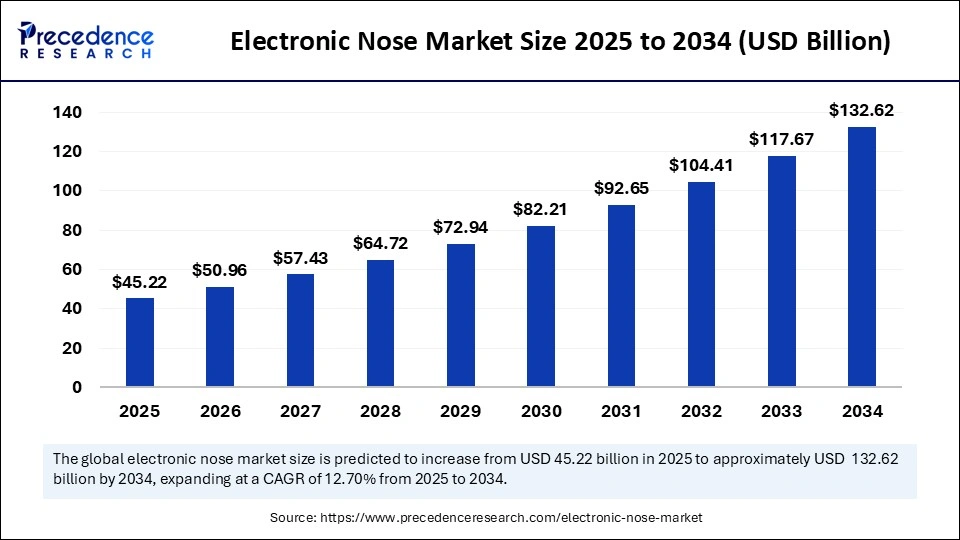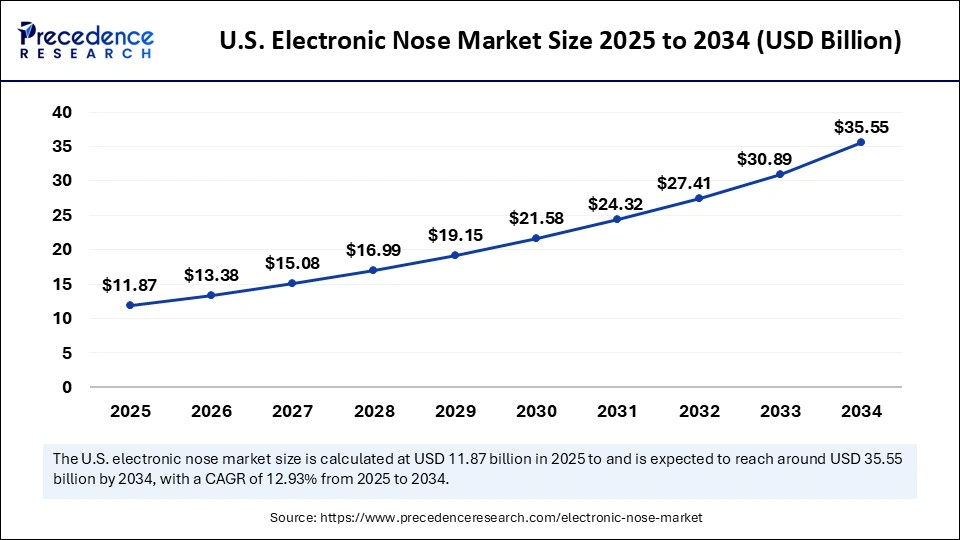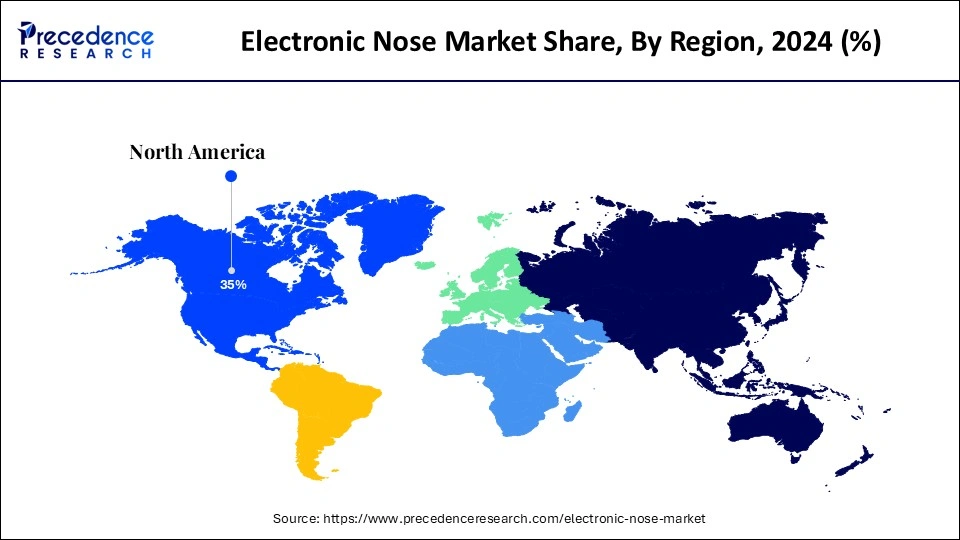List of Contents
Electronic Nose Market Size and Forecast 2025 to 2034
The global electronic nose market size accounted for USD 40.12 billion in 2024 and is predicted to increase from USD 45.22 billion in 2025 to approximately USD 132.62 billion by 2034, expanding at a CAGR of 12.70% from 2025 to 2034.The rising demand for electronic nose for quality control and safety assurance in industries fuels the growth of the market. Furthermore, the increasing demand from healthcare organizations to enhance the capabilities of disease diagnosis, monitoring, and drug development contributes to the growth of the market.

Electronic Nose Market Key Takeaways
- In terms of revenue, the electronic market is valued at $45.22 billion in 2025.
- It is projected to reach $132.62 billion by 2034.
- The market is expected to grow at a CAGR of 12.70% from 2025 to 2034.
- North America dominated the electronic nose market with the largest market share of 35% in 2024.
- Asia Pacific is projected to experience the fastest growth in the coming years.
- By product type, the portable electronic noses segment held a dominant share of the market in 2024.
- By product type, the fixed electronic noses segment is projected to expand at a significant rate during the forecast period.
- By application, the food & beverage industry segment led the market with the largest share in 2024.
- By application, the environmental monitoring segment is projected to grow at a considerable rate during the predicted timeframe.
- By sensor technology, the metal oxide semiconductor (MOS) sensors segment held a significant share of the market in 2024.
- By sensor technology, the conductive polymer sensors segment is observed to expand at a notable rate during the projection period.
- By form factor, the compact segment captured a significant share of the market in 2024.
- By form factor, the modular segment is seen to grow at a rapid pace in the upcoming years.
Impact of Artificial Intelligence (AI) on the Electronic Nose Market
Artificial Intelligence is set to revolutionize the market for electronic nose by enhancing odor analysis and identification. AI algorithms, specifically machine learning, improve pattern recognition by allowing more accurate and efficient analysis of complex odor mixtures. Furthermore, AI enables automated odor analysis, minimizing the demand for manual interpretation and speeding up the process. AI, with the help of miniaturization and portability, facilitates the reduction of the number of sensors needed, resulting in smaller and more portable electronic noses without compromising performance.
- In August 2024, Ainos, Inc. announced that its AI Nose had made a remarkable breakthrough in factory automation with 79% accuracy in detecting 761 samples across 22 different volatile organic compounds. This is a considerable technological advancement in industrial manufacturing safety and smart manufacturing.
U.S. Electronic Nose Market Size and Growth 2025 to 2034
The U.S. electronic nose market size was exhibited at USD 10.53 billion in 2024 and is projected to be worth around USD 35.55 billion by 2034, growing at a CAGR of 12.93% from 2025 to 2034.

North America accounted for the largest market share of 35% in 2024. This is mainly due to its advanced and well-established technological infrastructure and considerable research and development investments, specifically in sectors like defense and healthcare. The diverse industrial landscape of the region, including pharmaceuticals, environmental monitoring, and healthcare, also fueled the need for electronic nose technology in various applications. Moreover, the presence of a well-established food & beverages industry bolstered the growth of the market. With the increased food safety and quality regulations, the need for electronic noses has increased in the region.
The U.S. is a major market because of its stringent environmental and food safety regulations, boosting the demand for electronic noses for environmental monitoring and quality control processes of food. There is heightened adoption of these noses in industries like healthcare, defense, and environmental monitoring.

Asia Pacific is projected to experience the fastest growth in the electronic nose market during the forecast period, primarily due to rapid industrialization and increasing awareness of environmental and food safety. The rapid expansion of food & beverages, petrochemicals, manufacturing, and pharmaceuticals industries supports market growth as these industries heavily focus on quality control and process optimization, in which electronic noses are essential. China plays an important role in the electronic nose market in Asia Pacific. The rising demand for sophisticated solutions, specifically in food safety, environmental monitoring, and industrial quality control, creates opportunities in the market. India is emerging as a major marketplace due to rapid industrialization. Regulatory bodies and governments of various nations have imposed stringent regulations regarding food safety and environmental sustainability, contributing to the growth of the market.
Europe is considered to be a significantly growing area. The growth of the electronic nose market in Europe can be attributed to various factors such as stringent environmental regulations and an increasing emphasis on odor monitoring in industrial zones. Moreover, Europe is considered a hub for research and development in sensor technology, which is pivotal for improving the performance and accuracy of electronic noses. The increasing concerns regarding food safety positively impacts the market in the region.
Market Overview
The electronic nose market encompasses electronic devices mimicking the human sense of smell by detecting and identifying odors or volatile compounds in the air. It leverages an array of sensors to capture the chemical signatures of different smells and analyzes them using pattern recognition algorithms. The market is experiencing significant growth due to technological advancements, particularly in sensor miniaturization, AI, and nanotechnology. These innovations facilitate precise smell detection. Electronic noses find applications in a range of industries, from healthcare and food & beverages to environmental monitoring.
Electronic Nose Market Growth Factors
- Expansion of the Food Industry: The need for food quality control and safety is rising. Food processing businesses use electronic noses for raw material inspection, quality checks, and process monitoring.
- Healthcare and Environmental Monitoring: Electronic noses are being explored for diagnosing diseases, detecting skin ailments, and monitoring air quality by offering promising applications in diagnostics and medical monitoring. Also, they are used to detect and analyze volatile organic compounds in air and soil, helping to monitor air quality and identify pollution sources.
- Technological Advancements: Technological advancements, like developments in sensor technology, such as compact and sensitive devices or sensor miniaturization, by opening more applications for portable and cost-effective devices and driving market expansion.
- Increasing Public Awareness: Increasing public awareness of food safety, environmental concerns, and the prospect of electronic noses in various applications is contributing to market growth.
- Military & Defense: Electronic noses are also used in military and defense applications for the detection of explosives and hazardous substances, or toxins.
Market Scope
| Report Coverage | Details |
| Market Size by 2034 | USD 132.62 Billion |
| Market Size in 2025 | USD 45.22 Billion |
| Market Size in 2024 | USD 40.12 Billion |
| Market Growth Rate from 2025 to 2034 | CAGR of 12.70% |
| Dominating Region | North America |
| Fastest Growing Region | Asia Pacific |
| Base Year | 2024 |
| Forecast Period | 2025 to 2034 |
| Segments Covered | Product Type, Application, Sensor Technology, Form Factor, and Region |
| Regions Covered | North America, Europe, Asia-Pacific, Latin America, and Middle East & Africa |
Market Dynamics
Drivers
Growing Demand for Automated Quality Control and Monitoring
The growing demand for automated quality control and monitoring is a key factor driving the growth of the electronic nose market. There is a high demand for automated quality control and monitoring in different industries, such as food & beverage, healthcare, and environmental monitoring, for detecting odors associated with food spoilage, contamination, and adulteration. This, in turn, boosts the demand for electronic noses in quality control. The rising need for accurate and real-time analysis of odors and volatile organic compounds, which are crucial for ensuring product quality, safety, and consistency, further drives the growth of the market.
Restraint
Higher Cost
A primary restraint in the electronic nose market is the higher cost of electronic noses, particularly advanced models. These models create complexities in data analysis and interpretation, limiting their adoption. Advanced electronic noses require ongoing calibration and repairs, increasing operational costs. Additionally, these noses also require skilled personnel for calibration, maintenance, and data interpretation, adding to operational costs. These factors create barriers, specifically for small businesses, hampering the growth of the market.
Opportunity
Integration of Advanced Technology
The major opportunity in the electronic nose market is the integration of advanced technology to improve the accuracy and efficiency of odor recognition and analysis. This enables more advanced analysis of volatile organic compounds, expanding the scope of applications, ranging from disease detection and food quality control to environmental monitoring. Moreover, advanced sensors enhance the accuracy of electronic noses in monitoring air quality, detecting pollutants, and assessing the presence of hazardous substances.
Product Type Insights
The portable electronic noses segment held the dominant share of the electronic nose market in 2024. This is mainly due to their ability to facilitate on-site real-time analysis, which is crucial for industries like food & beverage, environmental monitoring, and healthcare, where quick results are required. The increased demand for rapid testing and stringent safety and quality control standards bolstered the growth of the segment. Advancements in sensor technology are improving the efficiency of these devices, sustaining the long-term growth of the segment.
The fixed electronic noses segment is projected to expand at a significant rate during the forecast period. These noses are ideal for continuous monitoring in industrial environments where consistent data is required for process optimization, quality control, and environmental monitoring. These devices are often deployed in fixed locations like factories or labs, providing continuous and reliable odor analysis compared to portable alternatives. This makes them a valuable and cost-effective asset for various industries.
Application Insights
The food & beverage industry segment led the electronic nose market with the largest share in 2024. This is mainly due to stringent food safety regulations. Electronic noses analyze food quality, freshness, and authenticity, which are essential for maintaining food safety. Furthermore, these noses evaluate aroma profiles and quality control. Electronic noses are being increasingly used in the food & beverage industry for product quality inspection, batch-to-batch uniformity studies, contamination detection, and spoilage detection.
The environmental monitoring segment is projected to grow at a considerable rate during the predicted timeframe, owing to increasing environmental regulations, rising demand for efficient resource management, and increasing environmental concerns. Electronic noses are used to monitor the quality of air and water. They also help in identifying and mitigating pollution and contributing to more efficient use of natural resources.
Sensor Technology Insights
The metal oxide semiconductor (MOS) sensors segment held a significant share of the electronic nose market in 2024 due to their high sensitivity, cost-effectiveness, and ability to detect a wide range of volatile organic compounds. They detect trace concentrations of gases and vapors, making them ideal for environmental monitoring applications. They also find applications in disease diagnostics and food safety. MOS sensors are preferred for their rapid response, less power consumption, and easy integration. Compared to other sensor technologies, these sensors are relatively inexpensive and reliable, making them suitable for a wide range of applications.
The conductive polymer sensors segment is observed to expand at a notable rate during the projection period, owing to their versatility and customization. They offer enhanced sensitivity and selectivity for specific target analytes. Additionally, cost-effectiveness and ease of fabrication make them suitable for a wide range of applications, such as gas and vapor sensing, humidity sensing, biosensing, pressure sensing, and touch-tactile sensing.
Form Factor Insights
The compact segment captured a significant share of the electronic nose market in 2024. This is mainly due to the increased demand for portability and real-time analysis. Portable electronic noses are suitable for on-site monitoring in various applications. These noses are preferred for their versatility, affordability, ease of use, and cost effectiveness, making them applicable for a wide range of industries. Additionally, the reduced size and weight of compact electronic noses are suitable for a broader range of applications, including food quality control, environmental monitoring, and even medical diagnostics.
The modular segment is seen to grow at a rapid pace in the upcoming years. The growth of the segment can be attributed to the flexibility and adaptability of modular electronic noses. They allow for easy swapping of sensor modules to analyze different odors, pollutants, or substances, expanding the range of applications. This enables customization and integration with various sensor technologies and applications, such as data loggers, different control systems, and mobile platforms, by improving their functionality and usability.
Electronic Nose Market Companies

- WAGEM Monitoring Systems
- Tiger Nose Associates
- Cyranose
- SPEC Sensors
- Odotech
- Owlstone Medical
- Bedfont
- eNose Company
- Aryballe Technologies
- Cambridge Sensotecs
- Delphian Corporation
- Aethon
- Airsense Analytics
- Alpha MOS
- Smiths Detection
- Ionicon Analytik
Recent Developments
- In November 2024, a study published in Science Advances highlighted that researchers built an electronic nose that not only detects odors at the same speed as an olfactory system of mouse but also distinguishes between odors based on the patterns they create on the sensor over time.
- In February 2024, Ariese's PEN, a portable electronic nose, was developed to identify gases and gas mixtures. It leverages a variety of gas sensors and can be used in various applications, including environmental monitoring and healthcare.
- In August 2023, Odotech unveiled an advanced version of its odor monitoring technology, offering expanded possibilities for real-time monitoring of odor emissions in waste management. This technology is designed to assist municipalities in managing odor emissions more effectively.
Segments Covered in the Report
By Product Type
- Portable Electronic Noses
- Fixed Electronic Noses
- Handheld Electronic Noses
By Application
- Food & Beverage Industry
- Medical & Healthcare Industry
- Environmental Monitoring
- Defense and Security
- Industrial Manufacturing
By Sensor Technology
- Metal Oxide Semiconductor (MOS) Sensors
- Polymer Sensors
- Conductive Polymer Sensors
- Surface Acoustic Wave (SAW) Sensors
- Piezoelectric Sensors
By Form Factor
- Compact
- Modular
- Integrated
By Region
- North America
- Europe
- South America
- Asia Pacific
- Middle East and Africa
For inquiries regarding discounts, bulk purchases, or customization requests, please contact us at sales@precedenceresearch.com
Frequently Asked Questions
Ask For Sample
No cookie-cutter, only authentic analysis – take the 1st step to become a Precedence Research client